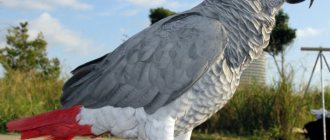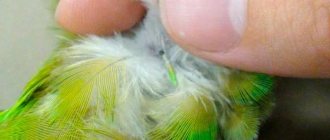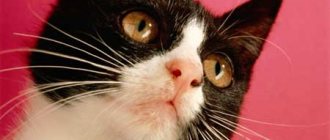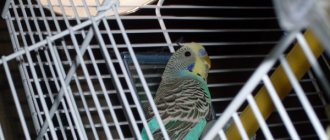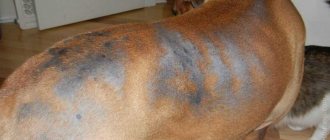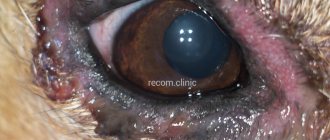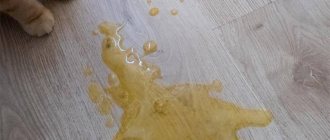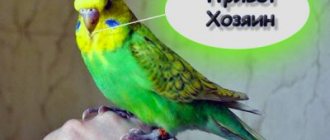Why does delamination occur?
When a pet gets sick, its beak becomes thin and fragile. Burrs are observed in some areas. The wax is covered with barely noticeable cracks and appears rough to the touch.
Beak separation can occur for a number of reasons:
- Lack of vitamins and minerals in the bird’s diet.
- Genetic predisposition.
- Bodily injury.
- Knemidocoptosis.
- Unfavorable indoor microclimate.
In some individuals, the beak grows too quickly, acquiring a hypertrophied shape. The bone tissue simply does not have time to form normally, so it begins to delaminate.
Injury
If a pet is injured, damaging its beak in some way, then during the regeneration process the surface is overgrown with a multi-layer protective film. In case of severe fractures, the outermost part dries out, and the remaining part also becomes covered with a white coating.
Knemidocoptosis
The disease gets its name from a type of tick. The activity of insects is manifested in the deformation of the beak, its peeling and delamination.
In addition to the unpleasant visual part, mites cause severe pain to the bird, which is why it constantly itches, sleeps anxiously and is in a state of stress.
If you carefully examine the bird, parasites can be seen at the base of the beak, as well as along the perimeter of the eye sockets. In the course of its activity, the pest creates a branched system of passages, which leads to the destruction of the bone structure, as well as to the appearance of delaminations.
Unbalanced diet
For the development of bones and beak in particular, the budgerigar's body requires a sufficient amount of calcium. If there is too little of it in food or for some reason the gastrointestinal tract does not absorb this element well, then hard tissues begin to peel off.
Lack of other vitamins and minerals can also cause beak splitting, but to a lesser extent. Therefore, nutrition must be balanced. Eating dry food alone is not enough: the diet must be diluted with fruits, vegetables and other products.
It is also useful to read: Fleas on a budgie
What to do
Having noticed a problem, the owner should look for associated symptoms. When additional signs are detected, you can take one of the first aid methods:
- With knemidocoptic mange, treatment is long-term and affects almost all non-feathered areas of the body. If a budgerigar's beak is peeling due to mites, the first thing to do is to put the budgie in a separate cage. It is necessary to protect other birds from contagious diseases. A sick pet must be treated with aversectin ointment every three days, excluding the eye area.
- If it is discovered that the beak is peeling due to a lack of minerals, the bird’s menu is immediately reviewed. Veterinary drugs are added to the feed, and the regular grain mixture is replaced with an enriched one. A good addition to the diet is sepia - the bird pecks at a mineral stone, swallows small pieces and at the same time grinds away the growing areas.
- If the dissection occurs as a result of injury or overgrowth, the bird can be treated mechanically. Special scissors are used to trim the defective stratum corneum, being careful not to touch the blood vessel. You cannot leave the bird in this state, otherwise part of the beak may break off.
Attention! Do not file the edges with a manicure tool. The cornea is riddled with nerve endings, and the bird will experience severe discomfort and pain.
The above information is the answer to the question of what to do if the parrot’s beak is already peeling off. How can we prevent this problem from arising at all? Use all available preventive measures.
We recommend reading: How to independently determine the age of a budgie
How to treat at home
As soon as your pet’s beak begins to peel and flake, urgent measures should be taken. First of all, it is necessary to adjust the bird’s diet. In addition to dry food, birds should be given sprouted grains, cottage cheese and boiled chicken eggs.
In pursuit of a balanced diet, it is important to ensure that the parrot does not overeat. Obesity in birds is very difficult and long to treat. Therefore, the daily norm must be strictly observed.
In order to cure a bird, veterinarians recommend mixing crushed chalk to the main food. If boiling eggs and feeding the bird cottage cheese is too troublesome, you can place a mineral stone or sepia in the cage. This will not only supplement the parrot’s diet with useful substances, but will also help him with grinding off the horny areas.
The microclimate in the room must correspond to the norm. Optimal conditions for budgies are +25⁰С with a humidity of 40-60%. Too high a room temperature and low humidity will cause the beak to split.
During the summer months, you can hang wet towels near the cage or use industrial humidifiers. In extreme heat, it doesn’t hurt to spray your pet with warm water from a spray bottle.
If peeling and tissue separation is caused by injury, then excess stratum corneum should be removed using a special tool. In this case, it is very important not to catch the blood vessels passing through the beak. Nail files cannot be used as a tool: the bird will experience severe discomfort.
Has your parrot been sick?
Not really
It is more advisable to shift any surgical intervention onto the shoulders of a specialist. The veterinarian has both the necessary tools and experience. You can remove only very small particles of the stratum corneum on your own.
If we are talking about the treatment of knemidocoptosis, then you should be patient. Getting rid of ticks is not so easy due to their tenacity and rapid reproduction. The first step is to isolate the sick bird from other pets.
Next, you need to carry out a complete disinfection of the cell. We remove all the accessories: drinking bowl, feeder, perches, bathing bowl, etc. For disinfection, it is better to use specialized industrial preparations. In the case of ticks, washing with soap alone cannot be done.
Many veterinarians prescribe Aversectin for knemidocoptosis. Depending on the level of infection, problem areas are treated with it every two or three days. Treatment is continued until the beak acquires a natural shine and familiar structure. When applying, it is very important to ensure that the medicine does not get on the animal’s mucous membrane, otherwise the pet will suffer from poisoning in addition to ticks.
Not all bird owners can make the correct diagnosis, so before using any medications you should consult a veterinarian.
Causes
Normally, a parrot's beak is smooth, strong and shiny, but it is possible that it may become dull and flake. The cornea is constantly growing, breaking off at the edges, old particles are replaced by young cells. If you do not take into account the natural growth factor, there are certain circumstances in which the formation of keratoid tissue is disrupted.
Then you have to think about why the beak suddenly peels off and how to fix it.
There are several reasons for defects to appear:
- power supply errors;
- conditions of detention;
- injuries;
- diseases.
An unbalanced diet leads to improper metabolism. Lack or excess of vitamins has equally bad effects on the functioning of internal systems. Monotonous grain feed and lack of fresh vegetables in the diet provoke vitamin deficiency. The lack of minerals affects the appearance: the beak flakes and peels, feathers fall off, and wounds appear on the skin.
Attention! Indulging in soft food leads to weakening of the muscles and edges of the jaw bones. Due to lack of work, the horny cover becomes thinner, flakes, and cracks.
Unsatisfactory microclimate parameters are a direct path to the budgerigar’s beak beginning to peel off. When air humidity is low, the shells dry out and cracks appear on them, which increase with feeding. The owner's illiteracy in keeping poultry also plays a role. If a pet is kept in a plastic cage with polymer perches and is not given wooden toys or twigs, it cannot sharpen its beak.
We recommend reading: Charming budgerigar Czech
Parrots get injured during conflicts with their cagemates and injure themselves when trying to bite a hard object. After hitting your head against a wall or mirror, blood circulation in the vessels is disrupted and the horny areas peel off.
One of the reasons why a parrot's beak peels and peels is the disease knemidocoptic mange. Scabies mites parasitize the skin and stratum corneum, destroying the structure of the epidermis. Severe itching occurs, which can result in tissue cracking, as the bird is constantly itching.
What to do for prevention
In order for the parrot to be healthy, including its beak, you need to take care of three things: nutrition, microclimate and cleanliness. The bird must receive all the vitamins and minerals necessary for its body, not be overheated or hypothermic, and also live in a clean cage.
Expert recommendations:
The cage should be kept away from heating devices. It is unacceptable for direct sunlight to fall on your pet.- In the winter months, if there is a lack of ultraviolet radiation, the room where the cage is located should be equipped with lamps. Your pet needs light at least 8 hours a day.
- The parrot must receive the elements necessary for bone growth. A mineral stone, sifted sand and/or sepia should be placed in the cage.
- All branches brought from the street must be doused with boiling water or disinfected with industrial means.
- Avoid low or high humidity. As soon as the level crosses the 80% mark, the doors to fungal infections will open.
- At least one perch should be irregularly shaped or made of an abrasive material to encourage the bird to groom its beak.
- Eliminate plastic from the cage (toys, crossbars, etc.), replacing it with natural materials or environmentally friendly synthetics.
- Give your pet fresh fruits and vegetables periodically. For chicks in the form of a paste, and for adults - in small pieces.
- Regularly inspect your bird for parasites.
Prevention
To prevent cracking of the parrot's feeding organ, all possible causes should be dealt with. To prevent drying out, you need to use a humidifier. This could be a primitive sprayer. You should review the diet and switch to professional nutrition, eliminating the mineral and vitamin supplements added to the general feeder. The optimal way to provide the body with biological catalysts is to use vegetables, fruits, herbs or sprouted grains.
Branches are a good tool for grinding
The bird itself senses when it lacks calcium. She begins to chew on the sepia or mineral stone, which should be attached to the cell wall. At the same time, the beak will be evenly ground down. For the same purpose, it is useful to keep branch food in the cage. It’s fun for the parrot, and it wears off its beak. If proper feeding and comfortable keeping are observed, the immune system will not weaken and excessive reproduction of the mite will not occur.
If a parrot's beak splits, it means the owner is doing something wrong. He needs to analyze the situation, resort to treatment if necessary, ensure comfortable maintenance and rational feeding of the pet.
We invite you to join our Zen channel and group on VKontakte or Odnoklassniki, where new articles for pet owners are published.
Similar articles:
- Top 5 Mistakes of Budgerigar Owners
- Feeding the finch correctly
- Fleas on a parrot: how to help an exotic bird?
Why does the beak peel off?
The beak of the Corella parrot is quite powerful. In order to sharpen it, special mineral stones are placed in the cage. They are easy to find at a pet store. The beautiful beak looks smooth, does not interfere with the parrot and there are no new growths on it. Why then does the cockatiel parrot's beak peel off? There may be several reasons:
- deficiency of vitamins in the body of a feathered pet, lack of fruits and vegetables in the bird’s menu;
- normal shedding;
- depression or severe stress;
- symptoms of certain diseases that require immediate treatment.
The first reason can be easily solved; vitamins and natural fruits are included in the parrot’s diet. Ideally, specialized supplements should be regularly included in the cockatiel's menu. Vitamins are usually given in courses; it is better to choose a liquid product. They are easier to dose and are easily absorbed in the body of a feathered pet.
It is also forbidden to give food from the human table. The parrot will undoubtedly like salty foods and sweets, but such delicacies will lead to digestive tract upset or metabolic disorders. This will then lead to obesity and cause destruction of the cornea on the beak.
Molting in cockatiels is a seasonal or age-related phenomenon. In addition to peeling in the beak area, feather loss occurs. During this period, the feathered baby also needs to be given additional vitamins. It is better to consult a veterinarian who will prescribe an effective complex.
Stress is no joke, especially if a bird has recently appeared in the house. A change in environment and owner can cause panic and even depression in the bird. During this adaptation period, it is important to provide the parrot with peace and spend as much time as possible with him. You should talk to your cockatiel quietly and in a calm tone. This type of parrot is also shy. Any loud noises or screams can cause fear and lead to depression. To fight it, it is worth determining the cause of its origin. The treat will help calm the parrot; free flights outside the cage are also recommended. The main thing is not to forget about a safe environment before releasing your cockatiel into the room.

